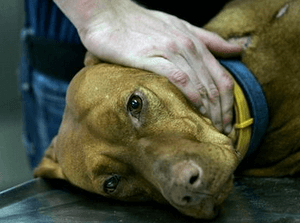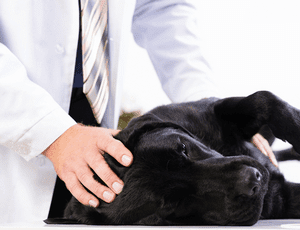 Salmonellosis in dogs is a serious disease caused by a specific type of bacteria. The animal has a malfunction of the digestive system and fever. How does an animal become infected, how dangerous is the disease?
Salmonellosis in dogs is a serious disease caused by a specific type of bacteria. The animal has a malfunction of the digestive system and fever. How does an animal become infected, how dangerous is the disease?
Salmonellosis is a disease that occurs when salmonella bacteria enter the body of a dog or cat. Several types of such microorganisms are known. They are found everywhere - in water, soil, manure, and are resistant to low temperatures.
The disease poses a serious danger to dogs. Young animals and puppies are most often affected. In adults, salmonellosis occurs in a milder form due to the developed immune system. In the absence of proper treatment, the disease leads to the development of negative consequences and death of the pet. This infection is transmitted from dogs to people, and therefore requires careful attention and prompt access to a medical facility.
Do dogs get salmonellosis?
Farm animals are often susceptible to salmonellosis, and cases of infection in the wild are also common. Pets get sick less often, but the risk of infection always exists. Salmonellosis often occurs in puppies; this occurs during the transition from mother's milk to food.
Poor quality of maintenance or cramped living conditions also lead to an increased risk of dog disease. There are frequent cases of bacterial poisoning when changing teeth, infection with worms, and infectious intestinal diseases.
Sources of infection in animals
How does salmonella become infected? There are a number of factors that can provoke the development of the disease.
Causes
- Infection from a sick animal is one of the main causes. According to statistics, 18% of dogs are carriers of salmonella. Shared leashes, bowls, and bedding are places where other individuals become infected.
- Poorly processed industrial feed, the presence of contaminated raw meat, fish or eggs in the animal’s diet.
- The disease is often diagnosed in dogs that have eaten mice or rats. Salmonellosis is also carried by insects.
- In adult dogs, infection often occurs through personnel working with sick animals. There is a high risk of developing the disease in pets living near farms.
- Salmonellosis is transmitted through the placenta, puppies become infected, and death occurs a few days later.
There are many ways to poison a dog with harmful microorganisms; the owner needs to closely monitor the behavior and condition of the pet.
Symptoms of salmonellosis in dogs
How does salmonellosis manifest in dogs? The disease occurs in three forms. In the acute and subacute type, the disease manifests itself two to three days after infection; in the chronic form, the incubation period is a week. All forms are characterized by the presence of certain symptoms and signs.
Acute stage:
- Increased temperature;
- Deterioration of the animal’s well-being;
- Lack of appetite;
- Vomiting;
- Intense diarrhea, streaks of blood are present in the feces;
- Feverish state;
- Pain in the abdominal area;
- Yellowness of the whites of the eyes, gums, mucous membranes;
- Damage to the brain and nervous system;
- Joint problems;
- In pregnant individuals, miscarriages are possible;
- Respiratory dysfunction;
- In severe cases, death of the animal;
In the subacute stage, symptoms develop in a similar way, but are less pronounced.
The chronic form of the disease is characterized by a sluggish development of symptoms, occasionally nausea, vomiting, and diarrhea. Often the signs are so weak that the owner is unaware of the dog’s illness. Lethargy, apathy, and exhaustion also indicate a possible illness.
Tests to detect bacteria
Before making a diagnosis, a thorough examination is carried out. Bacteriological culture is required; salmonella is found in feces, blood, and urine. The environmental situation and the animal’s place of residence are taken into account.
The veterinarian examines the dog, talks with the owner, and clarifies the living conditions and diet of the individual. After receiving the research results, the diagnosis is confirmed and the necessary medications are selected.
Treatment of salmonellosis in dogs
 Salmonellosis must be treated as soon as possible. Various procedures and medications are prescribed that can cope with the disease and toxic manifestations.
Salmonellosis must be treated as soon as possible. Various procedures and medications are prescribed that can cope with the disease and toxic manifestations.
Procedures:
- Proper nutrition is selected. Food should be light, easily digestible, and not irritate the stomach and intestines.
- At the first stages of the disease, a specific serum is introduced that reduces the toxic effect of bacteria. Administration of immunoglobulins is acceptable.
- The use of antibacterial drugs is mandatory. The choice of product and period of use is made by a veterinarian and depends on the condition, age, and size of the dog.
- Sulfonamides will help cope with diarrhea and blood in the feces.
- If necessary, enemas with medicinal solutions are prescribed; it is allowed to administer nitrofurans in quantities corresponding to the size and age of the animal.
- It is imperative to provide the dog with the correct drinking regime; it is permissible to add potassium permanganate or furatsilin to the water.
- If necessary, medications for the respiratory system are prescribed.
- The dog should always have fresh food and water, and hygiene is important.
- Self-treatment at home is not allowed.
Particular attention is paid to the pet's nutrition. The diet includes lean meat, dairy products, porridge (heavily boiled), and boiled vegetables. After a week, you can give your dog fresh meat and liver. It is not allowed to use dry food or stale food for feeding.
Prognosis and prevention for the animal
With proper and timely treatment, the prognosis is favorable. The dog recovers and returns to a normal lifestyle. In advanced cases, the disease progresses quickly, and death is not excluded.
How to protect your dog from salmonellosis? Preventive actions will help avoid disease.
Measures:
- Monitor your pet during a walk, do not let him pick up food from the ground;
- Follow the rules of hygiene;
- Raw meat is allowed to be given to a dog only if you are confident in its freshness and purity;
- Avoid contact with sick animals;
Salmonellosis is a dangerous disease that can lead to the death of an animal. If negative symptoms are detected, you must contact a veterinary clinic and begin treatment. Compliance with prevention will help to avoid an unpleasant disease and maintain the health of your pet.
Leave a Reply